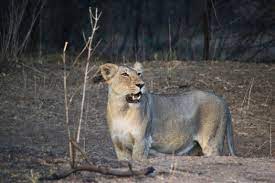West African lions are heavily endangered with just 400 members remaining. While the west African population of the Asiatic lion is less at risk than the Gir forest population – being spread over 4 unconnected sites, it would be impossible for an epidemic to wipe out the whole population, or indeed some sort of freak flood or other dangerous weather.

However, with each population only numbering around 100 the genetic variability is by definition likely to be lacking in each single destination.
Senegal host one of these last habitats in a national park called Niokolo Koba National park, which spans over 9000 square km, or about 3500 square miles. A 2011 carnovore survey only counted about 15 lions, the park is capable of potentially hosting thousands, however it is easy for poachers to get in and out of the park. As a result, however much or little the lion has been targeted, its prey species have crashed..
Forest elephants used to occur here in healthy numbers – currently the official number remaining is just 1, though a local truck driver claimed to have seen 3 together. Black rhino, giraffe and Tiang have all been lost. Thankfully all other species are thought to be holding on, including west african Lord Derby eland. Western hartebeest, Western crocodile, chimpanzees, west africas only population of wild dog (a pack of 20 was recently seen) as well as west africas largest population of leopards.
The lion population has grown to 30-40 individuals. A drive through the park does show small numbers of each species of animal, however each seems to have areas which it still lives in good numbers which suggests that a rapid recovery is still very much possible.
